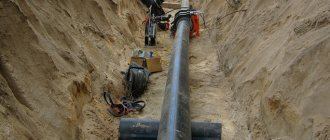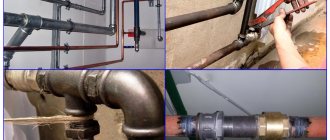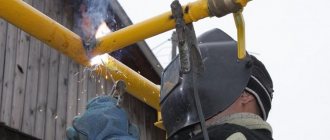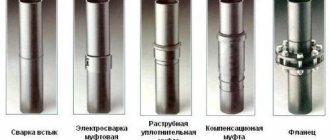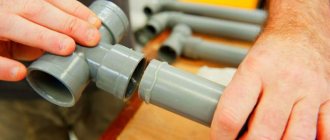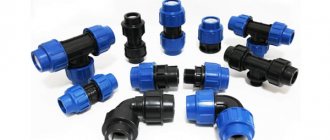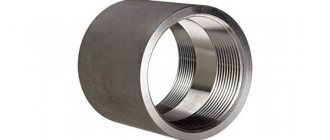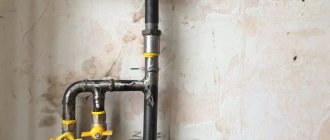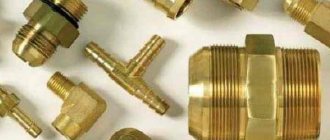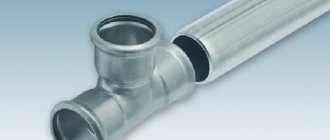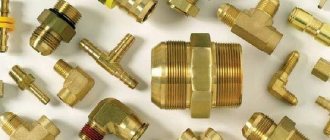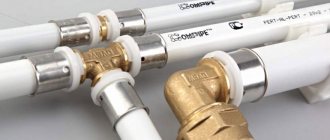The gas pipeline system is assembled from pipes using fittings - connecting elements for connecting to gas appliances for heating, hot water supply, stove, and gas meter. The requirements for fittings for gas pipelines are increased, since not only the efficient operation of the devices, but also the health of the people in the room depends on the tightness and strength of the connections.
Types and characteristics
There are many different devices designed for installing gas pipelines. According to the type of connection, fittings are:
- With thread (cylindrical). They are screwed onto a gas pipe and provide for preliminary sealing of the joints with flax, fum tape, etc.
- Welded castings secure the seam over the joint.
- Electrofusion ones are equipped with a spiral, which heats up when current flows and welds the parts from the inside.
- Flange fittings are used when connecting steel elements of large diameters. A distinctive feature is the ability to disassemble the connection at any time.
- Crimp adapters are the most reliable connections. They ensure tightness even when exposed to vibration.
- Press fittings are equipped with a fitting and a sleeve, which, after installing the end of the pipe, is clamped until it is completely fixed.
- PVC fastenings come in various configurations.
Depending on the location and purpose of location, fittings are divided into:
- Couplings designed to connect elements with the same diameter.
- Bends and angles - provide a change in the direction of the pipe at a given angle.
- Tees - installed to create one additional outlet.
- Crosses - designed for equipping branches in two directions.
- Adapters - help connect pipes with different diameters.
- Plugs - installed if it is necessary to create a tight connection at the end point of the system.
- Fittings - used to fix a flexible hose.
When selecting gas pipeline elements, it is necessary to take into account the requirements of regulatory documents regulating the installation and operation of these structures.
Preparation for installation work
Before installing the systems, you need to complete the following preparatory work:
- Make passage holes for pipes (walls, floors, foundations) for laying gas pipeline pipes;
- If you plan to hide a gas pipeline, you need to prepare grooves for it;
- The floors where gas equipment will be placed must be ready;
- When installing equipment on the wall, the walls are plastered;
- Plumbing and equipment to which gas and hot water will be supplied must remain in place.
Selection of gas fittings
Various fittings for gas equipment and connecting individual elements of the system are not suitable for every pipe. Connection to the gas pipeline and its branching to the points where various devices operating on blue fuel are installed is carried out by those products that are most suitable for each other.
For steel pipes
If a steel pipe is used when installing a gas pipeline system, fittings for it are taken from the same material. The size of the elements is ½ inch, which is enough for an unhindered gas supply.
The fitting and steel pipe are connected in two ways - threaded detachable and welded one-piece. The second method is used for joining and fastening together the structural parts of the gas pipeline by welding them with a circular seam between adjacent elements or using electric arc technology.
If it is necessary to create a temporary connection at the connection point of a gas stove or boiler, the threaded method is used. To begin with, a bend with turns is cut on the pipe using a die. To ensure tightness, a sealant (fum tape, tow) is placed over the entire area. Screw on the locknut and then the fitting. Fastening points for gas equipment are made in the same way, connecting the fitting to the thread on it.
It is necessary to paint the pipe to prevent its destruction under the influence of harmful factors. You can choose any color indoors, but outdoor areas are usually painted yellow.
For polyethylene pipes
When creating a gas supply from polypropylene pipes, plastic fittings are used and connected by welding. This system is durable and airtight. To carry out all the work you will need special equipment. During the installation process, adjacent elements are heated and glued together, becoming a single whole.
To create a detachable connection, combined fittings are used, which on one side are a polypropylene base, on the other - a metal thread. First, one side is welded, and then the gas equipment is connected by screwing the coupling onto turns.
Due to the need to connect pipes of different diameters, connecting elements are produced in different sizes.
For metal-plastic pipes
When working with metal-plastic pipes, brass fittings are used, which have high strength and a long service life. As in the case of metal and polypropylene systems, fastening is carried out using a permanent and detachable method using various products.
The most reliable and easiest to use are press fittings equipped with a special capsule around the fitting.
Anaerobic adhesives and sealants
This material has good viscosity and liquid consistency. They can remain outdoors for a long time without changing their properties. When they enter threaded connections where there is no air, they polymerize without shrinkage. The result is a very strong and hard substance, similar in properties to plastic. It provides excellent sealing and completely fills the gap in the thread, regardless of the pressure of the liquid or gas in the pipes. An important advantage of anaerobic adhesives is that they turn into a solid substance only in threaded connections, and in the open air they retain a liquid form and do not clog equipment and valves. They can be easily removed from the surface. This material is widely used in industry.
Anaerobic adhesives can be easily applied straight from the package. When carrying out large-scale work, it is worth using dispensers. Different types of adhesives have different polymerization times for the substance, from 3 minutes to several hours. The choice of a specific adhesive depends on the technical task. If you need quick installation, then you should use glue with a short hardening time. In a situation where the connection needs to be adjusted, then you can choose an adhesive that takes on its final shape after some time.
A connection sealed with anaerobic glue can be disassembled using ordinary tools. After hardening, the glue is non-toxic, which allows it to be used in the food industry. The operating temperature of anaerobic sealants ranges from -55 to +150 degrees Celsius. Some types of glue can withstand up to +200 degrees. When briefly exposed to higher temperatures, they can continue to do their job without changing properties. The cost of anaerobic adhesives is higher than other types of sealants. However, they fully honor the advertised price. The reliability of the connection using anaerobic glue is much higher than that of any other material. Each owner chooses for himself what is more important to him: confidence and reliability or the likelihood of large losses in the event of a system failure.
The undoubted advantages of anaerobic adhesive-sealant include ease of use, thread sealing regardless of force, easy installation of the system due to its lubricating properties, the ability to withstand greater gas or liquid pressure, better price-quality ratio, and retention of liquid form in the open air.
The disadvantages of this substance include the inability to use it in oxidizing and oxygen environments and at low temperatures due to an increase in polymerization time. This composition can only be used on dry threads and is not recommended when installing pipes with a diameter larger than M80.
Installation
Establishing connections using different methods has its own rules and nuances. If you decide to carry out the work yourself, you need to carefully study each process.
The simplest is the installation of a structure made of polypropylene pipes. To implement it you will need a special soldering iron. After connecting two adjacent plastic parts, it is put on the joint and heats the material to a predetermined temperature, at which it sticks together, but does not have time to melt.
To make a threaded connection, the pipes must have an external thread. In this case, fittings are used with internal threading of turns. After sealing the fastening point, one part is screwed onto the other until it stops.
The method of connecting metal-plastic systems using crimp fittings is radically different. To do this, the pipe is cut into segments of the required size, the edges are cleaned and a crimp clamp and nut are put on them. After the pipe is pulled as tightly as possible onto the fitting, it is partially fixed by installing a clamp, and then the nut is tightened until cracking appears.
Inset
To carry out such work, special qualifications and permission from the relevant authorities may be required. Produced in two ways:
- Hot method. In this case, a gas cutter or arc welding machine is used. The process boils down to cutting a hole in the main pipe and fixing the corresponding transition element. In this case, at the work site, the pressure should be reduced to 40–150 kg per cm 2. If done incorrectly, it can result in fire and accident.
- Cold method. In most cases no change in pressure is required. All actions are carried out using a special device. This is what we will consider next.
First of all, the area where the work will be carried out is thoroughly cleaned. Insulation, paint and rust are removed. A special adapter with a flat valve is welded to the prepared place. The quality of the manufactured seam is checked using the crimping method. It must be without shells, and also able to withstand the planned pressure. The following sequence is:
- Drilling equipment is being assembled. It is important not to forget to install a magnet on the base of the drill.
- A drill connector is attached to the previously mounted adapters.
- Measurements are made of how far the rod should be lowered.
- The intermediate chamber is tested for the expected pressure with an air compressor.
- Rotation from the motor is transmitted to the drill through a gearbox. This makes it possible to reduce speed.
- After passing through the walls, the crown rises to the required level and the valve closes.
- The pressure in the chamber is released, and the drill is removed along with part of the pipe.
- An additional nozzle is installed, through which the pipe is inspected and the remaining chips and other debris are removed.
- Excess pressure is released again. All additional parts are removed and the outlet line is installed.
- The damper is removed, and the connector under it is closed with a weld.
This article describes most of the available methods for connecting gas pipes. Which one is required in a particular case will depend on what is provided for in the project.
Connections of pipes and gas pipeline parts
12
Pipe connections should be permanent. Connections between steel pipes and polyethylene pipes can be detachable, as well as at places where fittings, equipment and instrumentation are installed. Connections of steel pipes are usually made by welding. In this case, arc (manual, semi-automatic and automatic submerged arc) and gas welding, butt resistance welding, gas shielded welding and soldering are used.
The types, structural elements and dimensions of welded joints must comply with the requirements of current standards. For steel underground
For gas pipelines, butt and corner connections must be used; for polyethylene pipelines, butt connections must be used with a heated tool or using parts with embedded electric heaters. The seams should not have cracks, burns, unwelded craters, as well as unacceptable displacements of edges, lack of fusion, inclusions, pores, misalignment of pipes and other defects that reduce the mechanical properties of welded joints. Detachable connections are made on threads and flanges. Threaded connections are made using connecting parts (fittings) on cylindrical pipe threads in accordance with GOST 6357-81 (Fig. 3.3).
Figure 4.3. Connection of steel pipes on a thread: a) on a short thread, b) on a long thread (sweep), c) fitting;
1 - pipe, 2 - coupling, 3 - lock nut, 4 - fitting, 5 - union nut
To create a hermetic connection of pipes, the threaded connection is sealed with flax strands or by winding fluoroplastic tape FUM (see laboratory work No. 2). Connecting parts for steel water and gas pipes are made of ductile iron or steel (Appendix 3). The end planes of the fittings must be perpendicular to the axes of the passages and have chamfers.
Figure 4.4. Swagelok collet joint:
1 - fitting body; 2.3 front and rear ferrules; 4 – union nut
On external gas pipelines, flange connections are used to install valves, taps and other fittings. On internal gas pipelines, flanged and threaded connections are allowed only for connecting shut-off valves.
See Figure 4.5. Varieties of round flanges are shown.
In most cases, flanges are made of steel V StZ sp. The choice of flange design depends on the operating parameters and physical and chemical properties of the transported product, and on the pipe materials.
Flanges are installed on the pipe by welding, as well as by flanging the ends of the pipes or rings welded to the pipes. Flanges used for connecting fittings, equipment and instruments to gas pipelines must comply with GOST 12820-80 and GOST 12821-80 for Ru=0.1;0.25; 0.6; 1.0; 1.6 and 2.5 MPa.
The tightness of flange connections is achieved by using gasket materials in accordance with the requirements of SNiP 42-01-2002.
When installing internal gas pipelines and impulse lines from copper pipes, high-temperature hard soldering is used, and telescopic (capillary) solder joints of types PN-4 are used; PN-5 according to GOST 19249-73 (Fig. 4.6).
Figure 4.6. Soldering copper pipe connections
The symbol for solder joints consists of:
— alphanumeric designation of the type of solder connection;
— solder joint thickness;
— standard designations (GOST).
For example: PN-5 0.1*15×47 GOST 19249-73 full symbol of the telescopic solder joint PN-5 0.1 mm thick, 15 mm wide, 47 mm long.
To connect shut-off valves and measuring instruments to a copper gas pipeline, brass adapter parts should be provided.
In Fig. 3.7. A diagram of connecting shut-off valves to a copper gas pipeline is shown.
Figure 4.7. Diagram of connections of shut-off valves to copper
gas pipeline
Connections of polyethylene pipes should be permanent. Connecting parts made of polyethylene are manufactured according to TU 6-19-359-87\6 (Appendix 3). Butt welded joints are used with a heated tool or using parts with embedded electric heaters (HH).
In Fig. 4.8 shows schematic diagrams of connecting polyethylene pipes by welding and a flange connection.
The seams should not have cracks, as well as edge displacements and pipe misalignments that are unacceptable in accordance with the requirements of regulatory documents.
Connections of polyethylene pipes with steel pipes, as well as connections in places
installation of fittings, equipment and instrumentation.
Detachable connections of polyethylene pipes with steel pipes in the ground can only be provided if a case with a control tube is installed.
Conclusion: we became familiar with the structure of gas pipelines, the materials of pipes and connecting elements during their construction.
Insulating flange
1 - pipe wall; 2 - free flange; 3 - bolt with nut and washer; 4 — textolite bushing; 5 — textolite washer; 6 - welded ring; 7 - weld; 8 — textolite ring; 9 - Klingerite gaskets
Insulating connections are installed on the above-ground vertical sections of the inputs and outputs of the GRP and cabinet-mounted GRU (SHRP), as well as in front of the GRU to protect against stray currents. The most common insulating connections are flange connections IFST, IFS, SI, IS.
The figure below shows the design of an IFS type insulating connection, which is installed after the shut-off valve along the gas flow. In a flange connection, in addition to two main flanges welded to the ends of the gas pipeline being connected, there is a third flange, the thickness of which depends on the diameter of the gas pipeline. Between the flanges, for the purpose of their electrical insulation, paronite (vinyl plastic or fluoroplastic) gaskets coated with electrically insulating bakelite varnish are installed. The section of the fluoroplastic sleeve contains tightening pins, and between the nut washers and flanges there are also insulating gaskets made of paronite coated with bakelite varnish. Along the perimeter of the special flange there are threaded sockets into which screws are screwed in to check the electrical resistance between the main flanges and the special flange.
How to connect gas pipes
More and more people are trying to do all the necessary work on their own, but what to do if a person simply does not have certain skills and knowledge? In such a situation, you just need to follow the instructions that professionals can give. This article provides information on how to connect gas pipes yourself using special tools and auxiliary materials.
If you decide to carry out work on connecting the gas pipeline yourself, then before starting the process, you need to study all the safety precautions. Check the integrity of the pipes located along the central line.
Shut off the gas supply throughout the house. If the work is carried out in an apartment, then it is best to block the neighbors’ risers for a while. If this is not possible, then turn the special key located on your gas pipe, thereby shutting off the supply.
Be sure to purge the remaining gas in order to eliminate the possibility of an explosion in the event of a spark. Only after you make sure that the gas is not coming from anywhere can you proceed directly to work.
Natural sealants
Jute and tow are used in conjunction with silicone sanitary sealants. The thread is cleaned of dirt and rust, coated with sealant, the sealant is twisted into a thread and wound clockwise flush with the thread crest. When winding, the seal is pulled with a force of 0.5-1 kg.
After winding, carefully coat with sealant and assemble the connection. Within 5-8 minutes, until the polymerization process is completed, it is necessary to check and, if necessary, tighten the connection further. Tightening the nut after the sealant has polymerized will cause leakage.
Stores sell ready-made plumbing thread for sealing pipes, made from flax. It doesn't need to be twisted. Before you buy a thread, read on the packaging what it is made of and whether it contains silicone or acrylic sealants. If it is a fluoroplastic thread, it is not advisable to use it on damaged threaded connections; if it is a vegetable thread without sealant, then purchase sanitary sealant separately.
Owners of apartments and houses ask: “Which thread is best for pipes?”, meaning the brand. To which a professional plumber will answer: “Better is the thread that was skillfully wound.”
If there is more or less thread than required, or it is not wound along the threads, the connection will leak. Do not wind it “with reserve”, wind it as much as necessary and do not forget about the sealant.
Types of pipe connections
There are several main ways to connect gas pipes, or rather:
- Welding - carried out exclusively by specialists who have permission to work with a welding machine. Each employee must have a personal identification card.
- Threaded or fitting - also involves welding lightweight pipes, with the sockets sealed using hemp fiber. The whole process of work is very much reminiscent of connecting sewer pipes. It is worth noting that the fiber is pre-impregnated with a solution of linseed oil or drying oil. You can also use couplings that can have either long or short threads.
- Flange is one of the most common connection methods, as it has a fairly lightweight assembly design. However, according to experts, it is less reliable than welding.
All of the connection methods described above are used by professional craftsmen using specialized equipment.
In order to independently connect gas pipes in a house or apartment, you need to prepare the following tools and materials:
- gas adjustable wrench;
- tow and grease;
- hoses or pipe connections;
- if necessary, a connector with threads on both sides.
Linen
Linen thread is an old, but proven method of compaction. In addition, you can purchase it at plumbing stores.
There are some factors to consider before purchasing:
- what is the thickness of the strand;
- whether there is an unpleasant odor or particles of debris;
- Is the thread elastic enough?
It should also be taken into account that flax is not suitable for all pipeline systems. Water and temperature lead to rotting, and in the heating system it will burn out in a short time.
Modern sealing pastes are better at preventing rust on connecting fittings and gas pipes.
Red lead is usually the most used material. DIY pasta is cheap and cheerful. To do this, take whitewash and pour in drying oil little by little, stir the mixture until it becomes similar in consistency to sour cream.
Apply a small, thin layer directly onto the thread itself. Evenly distributing and drying the material. Lead white is best used for working on steel pipes.
Due to the fact that the upper layer of iron is oxidized, insoluble compounds do not allow ozone molecules to pass through, according to the principle of enchantment.
Purchase ready-to-use hermetic pastes from specialized stores:
Gebatout 2 (paste based on mineral fillers and synthetic polymers). Pastum GAS (corrosion inhibitor, fillers).
Multipak (natural paraffin oil with minerals included). Unipak (natural minerals, fatty acids). The absence of the above funds is not a problem at all.
The working process is as follows: we separate part of the flax from the entire skein, two matches thick. We wind it onto the threaded connection, starting from the base of the pipe and to the end.
Then we coat the formed structure with paste, this is necessary so that the connections are tightly held together.
Technological process
If you turned off the gas supply and purged the pipes, as recommended earlier, then the next step is to cut off unnecessary parts of the gas pipes. To do this, you can use a grinder, and if you don’t have one, then a hacksaw is quite suitable, but in this case the process will be lengthy and more complicated.
After you have removed the unnecessary part of the gas pipe, you need to carefully weld or solder one end of it.
If you need to connect one end of the pipe to a gas hose, you will need to cut a thread on the sawn part. To do this, there is a special nozzle, putting it on, you will need to scroll several times.
Next, tow is wound onto the thread made, which is soaked with lubricant and a connection is made to the hose. All this work is carried out using a gas adjustable wrench. If you plan to install a new pipe, you can use a special connecting adapter. This element has a ready-made thread on both sides and a nut that is screwed onto the main and new pipes.
This method can be used in apartments, you just need to make sure there are no leaks. To do this, you need to open the gas supply, then apply a soap solution to all pipe joints.
If bubbles appear on the surface as a result of this action, all connections must be re-tightened.
If you have never done such work yourself before, then it is best to entrust this matter to professionals.
Sealing with linen thread
This method is the oldest. This is exactly how pipe connections were sealed in Soviet apartments. If the store does not have other sealants, then flax and plumbing paste are sure to be found. But this seal has a number of significant disadvantages:
- According to the rules, flax is used in combination with drying oil and red lead. Lead prevents corrosion of the joint, and drying oil fills the pores of flax like a polymer. But finding high-quality ingredients is quite difficult, so red lead is often replaced with iron, which only accelerates the oxidation of metal components. Some craftsmen get out of the situation by using silicone-based automotive sealants.
- The difficulty of laying linen thread on the thread. What is so easy for experienced plumbers can cause a lot of difficulties for a non-specialist. It is unlikely that you will be able to wind the flax correctly onto the joint the first time, and any error in performing this operation will lead to the seal not lasting very long.
- Len does not tolerate changes in working conditions very well. Therefore, in heating systems, its strands will collapse much faster. Also, this type of sealant does not react well to aggressive environments.
- The high hygroscopicity of the material leads to its swelling, which is why connections that are not strong enough can simply burst. For example, it is not recommended to use flax when sealing aluminum radiators.
Materials for sealing joints
Threaded and flange connections require additional sealing.
The choice of material for the gasket is carried out taking into account the fact that it should:
- withstand the loads specified by the design, including pressure drops;
- level out defects of the sealing surface;
- fill the space between connected elements.
That is, the gasket must be elastic, durable and dense. The most famous material that meets these requirements is linen. Flax strands are actively used to seal joints of gas and water pipes.
More modern materials - pastes, threads, sealants, FUM tape are used a little less often: due to the higher cost and some conservatism of experienced specialists.
Pros and cons of linen tape
Linen tape is tightly wound around the thread, creating a dense layer. The advantages of this method are low cost, high level of adhesion, strength of the fixed joint.
Disadvantages - destruction of flax over time, difficulty in dismantling, high requirements for the experience of a specialist.
If the connection of gas pipes on a laid thread is made with too much force, the gasket may break. Such a joint will not be airtight. Therefore, it is better if the manipulation is entrusted to an experienced master.
Pastes based on oils and resins
Oil and resin compositions do not harden. The substance applied to the joint remains viscous for a long time and effectively resists the penetration of gas into the external environment.
A big plus is the easy application, which even a novice mechanic can handle. Cons: lack of fixed fixation, low resistance to pressure.
As the pressure in the gas pipeline increases, the paste is gradually squeezed out of the connection.
Drying paste-sealants
The basis of these compositions are solvents. After application, the substance dries and provides a strong hold. Can be used alone or in combination with linen winding for gas connections.
Experts attribute the strength of the resulting joints to the advantages of drying sealing pastes. In addition, the composition is easy to apply: during processing it acts as a lubricant, and begins to dry out while already in the threaded gap. Disadvantages include a tendency to shrink.
